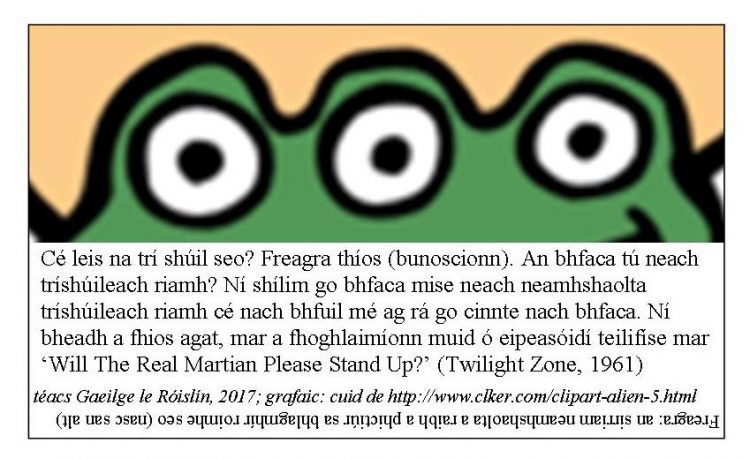A Glossary for the Irish in ‘Neacha Neamhshaolta’ (Tríshúileach / Three-eyed, or Otherwise), Cuid / Part 1 Posted by róislín on Feb 24, 2017 in Irish Language
The last few blogs may have introduced some new vocabulary, so let’s take a closer look at some of the words and phrases, starting with:
A.. “neach” (creature, being, person, spirit).
Note that all these definitions match up with other Irish words as well, often more primary:
1.. creature: créatúr (implying “poor creature” as in a “miserable thing”) or “dúil,” which also means “element”
2.. being: can be “gin” (something generated or begotten, often, but not always “offspring”) or, again, “dúil,” and also, although not in the sense of a living being, there’s the word “beith” (being, existence), this itself different, of course, from “beith, pl: beitheanna” (birch tree, birch trees” — Ó, iontas na homaghraf!
3.. person: much more typically “duine” (pl: daoine), and sometimes “pearsa” (for example, for labeling forms of verbs and prepositions, e.g. “sa chéad phearsa,” or, in the plural, “pearsana,” for listing the characters in a play)
4.. spirit: and this one I’d say is the jackpot, with the following among the equivalents:
a.. spiorad, for spirit or courage, and An Spiorad Naofa, the Holy Spirit
b.. sprid, spirit as a supernatural being or ghost; can be used for courage or morale, but for those, I’ve primarily seen “misneach” or “uchtach” and “misneach” or “meanma,” respectively
c.. taibhse, most typically, in my experience, ghost, sometimes “apparition” or “bogey”
d.. anam, usually “soul” (as in “anamchara“) sometimes “life” itself, though “life” is typically “beatha” or “saol”
e.. fuinneamh, typically “energy” or “vigor”
f.. meanma, typically “mind,” “thought,” or “morale”
g.. intinn, typically “mind” or “intention”
h.. faghairt, typically “fervor” or “fire” (in the abstract sense, not a physical “tine“), or more tangibly, the “temper” of metal. NB re: pronunciation: the “gh” is basically silent, simply affecting the vowel sound of the surrounding “a” and “ai.”
i.. and on the alcoholic side, but pretty far removed from the topic at hand, biotáille, which is really a collective noun for “spirits” or “strong drink” in general.
Bhuel, hopefully that has left you “lán d’anam” or with “barr do chroí agat” (in high spirits) and ready for a bit more vocab. So here goes, for “neamhshaolta,” but not before mentioning one of the more noteworthy phrases for “in high spirits,” namely “ag caitheamh do thóna,” literally something like “throwing your backside about.” To its credit, “ag caitheamh do thóna” can also mean “frisking about ” (like a lamb), but then, it can also mean “sitting about,” in which case I wonder if the implication is more like “wearing out your backside.” But more on that later — ábhar blagmhíre eile?
B. So here’s “neamhshaolta” (for pronunciation, remember the “m” and “the “s” are silent):
neamhshaolta: unworldly, unearthly, ethereal, alien (in the outer space sense, not re: immigration)
neamh– (prefix): un-, dis-, non-, in- (im-, il-, ir-), etc., as in “neamhchlaonta” (impartial), neamhléannta (unlearned), neamhliteartha (illiterate), neamhurchóideach (innocent), neamh-ionathnuaite (non-renewable), neamh-armónach (disharmonic), etc.
C. And, so we get at least one of the descriptions of the aliens from outer space covered in this blog:
tríshúileach, a fairly straightforward combination of “trí” (3) + súileach (-eyed), which becomes “shúileach” after “trí,” with a silent “s.” More typical for humans, and some aliens as well is “déshúileach,” binocular, lit. two-eyed, usually to describe vision in general (binocular vision as opposed to, say, multi-ocular vision), although this word is used to describe at least one animal as “two-eyed” (not “binocular”). Cé acu ceann? Is é pearóid fige dhéshúileach Coxen é, which, intriguingly is called Cyclopsitta diophthalma taxonomically. In English, it’s “Coxen’s double-eyed fig parrot.” But why is it “diophthalma” if it’s a member of the “Cyclopsitta” genus, which sounds like it should be one-eyed (“aonsúileach” or “ar leathshúil“)? But that question will have to wait for blagmhír éigin eile, perhaps with input from an éaneolaí. An bhfuil aon éaneolaí ar an liosta?
More glossary to come, but in the meantime, SFG — Róislín
nasc: Design Your Own ‘Neach Neamhshaolta’ and Describe It in Irish, or, What’s the Gaeilge for ‘I Have Two Antennae, or Three Eyes or Four Opposable Thumbs’?Posted by róislín on Feb 22, 2017 in Irish Language
PS: Seo an sirriam neamhshaolta, a chorp iomlan, trí shúil, dhá aintéine, agus eile!

Build vocabulary, practice pronunciation, and more with Transparent Language Online. Available anytime, anywhere, on any device.






Leave a comment: